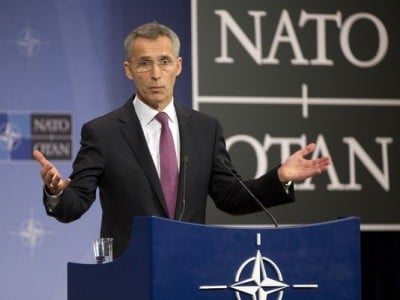NATO Insists on Russian Invasion Narrative to Justify New European Battlegroups

All Global Research articles can be read in 51 languages by activating the “Translate Website” drop down menu on the top banner of our home page (Desktop version).
To receive Global Research’s Daily Newsletter (selected articles), click here.
Visit and follow us on Instagram at @globalresearch_crg.
***
The predicted February 16 Russian invasion of Ukraine came and passed without incident. In fact, not only did Russian soldiers begin demobilization on February 15 with the end of defense exercises, but Russian officials even took the opportunity to mock the West for their bold announcement on when exactly the supposed invasion of Ukraine would begin.
Russian Foreign Ministry Spokeswoman Maria Zakharova requested on February 16 for Bloomberg, The New York Times and The Sun “to publish the schedule for our upcoming invasions for the year” so that, as she said, “plan my vacation.” A day earlier she said: “February 15, 2022 will go down in history as the day of the failure of western war propaganda. Humiliated and destroyed without firing a shot.”
Meanwhile, Lugansk defense militias accused pro-Kiev forces of firing in their area of control four times. Although it is not yet clear how serious these incidents are, there has been no reaction for now from Kiev or the Organization for Security and Co-operation in Europe (OSCE), which is monitoring the situation in eastern Ukraine but has withdrawn in recent days some of its observers from the region.
Representatives of the self-proclaimed People’s Republic of Lugansk said in a statement on February 17 that Ukrainian forces used mortars, rocket-propelled grenades and machine guns in four separate attacks. This shows that although the ridiculous invasion prediction obviously failed to materialize, with much humor, Kiev’s continued violations of the Minsk agreement is certainly no laughing matter.
In fact, this latest violation of the Minsk agreement is made all the more dangerous as the Anglo Alliance (US-UK-Australia, or AUKUS), refuses to backdown from its Russian invasion narrative. British Prime Minister Boris Johnson told United Nations Secretary-General António Guterres on February 16 that there was “currently little evidence of Russia disengaging” from its military buildup near Ukraine.
Boris was backed up by British Lieutenant General Sir Jim Hockenhull, the Chief of Defence Intelligence, who said in a rare statement that they “have not seen evidence that Russia has withdrawn forces from Ukraine’s borders. Contrary to their claims, Russia continues to build up military capabilities near Ukraine.”
In unison with Britain, US State Department spokesman Ned Price said they had in fact seen “more Russian forces” and “not fewer” along the Ukraine border. When asked why Moscow would claim to be withdrawing troops when US intelligence, commercial satellite photos and social media videos showed no evidence of that, Price said: “This is the Russian playbook, to paint a picture publicly… while they do the opposite.”
Perhaps the Anglo officials, intelligence agencies and media missed videos freely available of Russian troops and heavy equipment withdrawing following the end of their defense exercises.
It was NATO Secretary General Jens Stoltenberg who revealed on February 16 the likely reason why the Anglo Alliance is maintaining a Russia invasion narrative despite the major humiliation they experienced recently. After claiming that NATO is not a threat to Russia but that it must bolster its collective militaries because of the supposed Russian threat, he said the alliance was thinking about “establishing new NATO battlegroups in central and eastern, south-eastern Europe.”
In effect, rather than reciprocating Russia’s demobilization, NATO announced its consideration of new battlegroups geographically located with the obvious intention of surrounding and pressuring Russia.
With the Anglo Alliance failing to provoke Russia into war with Ukraine, it is now trying to find new justifications to increase troop numbers on Russia’s border. The only palatable way in the current climate for this to be achieved is to maintain a Russia invasion threat narrative, no matter how many times the Kremlin announces it has no intentions of this and no matter how many times the Anglo Alliance is humiliated with botched intelligence and failed predictions.
For this reason, Kiev will continue violating the Minsk agreement and attack Donbass defense forces knowing that there will be continued silence from the Anglo Alliance, NATO and the OSCE. Moscow is left in a difficult position as it attempts to navigate the manufactured Ukraine crisis with a diplomatic approach, but at the same time cannot tolerate and allow the Ukrainian military and its Far-Right militia allies to target and kill Russian passport holders in Donbass.
*
Note to readers: Please click the share buttons above or below. Follow us on Instagram, @globalresearch_crg. Forward this article to your email lists. Crosspost on your blog site, internet forums. etc.
Paul Antonopoulos is an independent geopolitical analyst.

